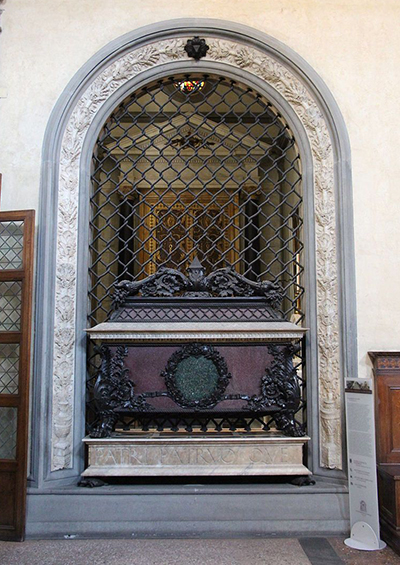The tomb of Piero and Giovanni de Medici is one of the most famous works of Italian painter Andrea del Verrocchio.
Piero and Giovanni de Medici was a ruler in Florence, Italy during the Italian Renaissance. His achievements and victory during the war had his benefit from his father's Medici bank. His father, Cosimo de' Medici was a wealthy ruler, who left all the financial assets he had to Andrea del Verrocchio, as his elder brother Giovanni died before named the Cosimo's executor.
Piero's tenure as a ruler was not all smooth. At some point, he had to overcome a coup, face a war against the Republic of Venice instigated by the Florentine support given to Galeazzo Maria Sforza, and battle his way out. He died in 1469 and was buried in the Church of San Lorenzo. The tomb, completed in 1472, makes a lovely entrance. Andrea's creation is made of coloured marble and porphyry and a little addition of bronze for the decoration.
Andrea del Verrocchio's father was a maker of bricks and tiles, then later a tax collector. Andrea was mentored to be a goldsmith. He took his last name from Giuliano Verrocchi, a goldsmith during his time. Andrea, later on, learned painting from artists like Alessio Baldovinetti, Sandro Botticelli and Fra Filippo Lippi.
The last 20 years of Andrea's life saw him produce notable work, that made him a huge name around Florence and beyond. Piero de' Medici and his son Lorenzo were fans of what he was doing and constantly supported his creativity. Andrea made paintings, sculptures, costumes, and ornamental armour for Florentine festivals and public occasions. He also curated art pieces for the Medici palace and helped them store portraits.
Like any other monument created at Florentine burial sites in the early ages, the tomb of Piero and Giovanni de Medici was created with marble, which was the popular thing to do. The sepulchral monument appears at the pavement above Cosimo's tomb to pay homage to the family. It was only fair that the tomb is placed next to Cosimo's as a sign of respect and honour to the dynasty. It's two-sided; appearing in an arch between the old Sacristy and what used to be the Chapel of Sacrament. This was crucial as it appeared to not be attached to any nearby tomb.
The design of the tomb gave a beautiful artistic impression and was distinct for the late fifteenth-century art. Andrea picked a unique design for the tomb. The monument which appeared luxurious to many was made with the expensive material. The sarcophagus was made out of stone with a little media; this was rare for stone coffins in Florence. Bronze, marble, porphyry and serpentine were the most commonly used for sculptures, as seen in the work of Brunelleschi and Donatello.
Andrea del Verrocchio used multiple colours for the Tomb of Piero and Giovanni de Medici. This made the tomb to stand out among others. Unlike his contemporaries who were only skilled in one medium, Andrea was skilled in both bronze and stone, making this work outstanding. The red porphyry sarcophagus has green serpentine medallions on both sides. The bronze decoration covers the sides of the tomb. It appears around the lion's claws on which it rests. The white Carrara marble lid and base. The base is inset with porphyry and serpentine design, making it similar to the slab tomb of Cosimo. This work made him known as the materials for the tomb and location chosen by Andrea del Verrocchio were not traditional.
Artists who were influenced by and were students of Andrea include Perugino, Sandro Botticelli, Leonardo da Vinci, Ghirlandaio and Perugino. The tomb of Piero and Giovanni de Medici has been featured in many art publications, with both modern day and renaissance artists drawing inspiration from the work.




